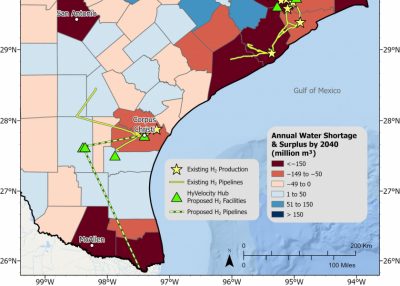Growing Water Needs for Texas Hydrogen Industry
There are many ways to make hydrogen, a carbon-free energy source and petrochemical ingredient. But no matter the method, all hydrogen production requires a lot of water.
In a recent study, researchers from the Jackson School of Geosciences examined just how much water a growing hydrogen economy in Texas might need. They found that new hydrogen production facilities could account for 2% to 6.8% of water demand in the state by 2050. The research was published in the journal Sustainability.

In comparison to other big water draws, such as irrigation or municipal use, hydrogen’s water demand might not seem like much. However, the water demand won’t be felt the same statewide. The research shows that the Gulf Coast counties — where most new hydrogen infrastructure is planned — are projected to be among the most water stressed in the state in the coming decades.
As the hydrogen industry grows, policy makers and communities should prioritize water planning and understand the various water supply options, said the study’s lead author Ning Lin, an energy economist at the Bureau of Economic Geology and member of its hydrogen energy research consortium GeoH2.
“This report is a great resource for anyone looking to understand the key aspects of water use in hydrogen production — from how much is needed to quality, processing and disposal,” said Lin.
The University of Texas at Austin
Web Privacy | Web Accessibility Policy | Adobe Reader

